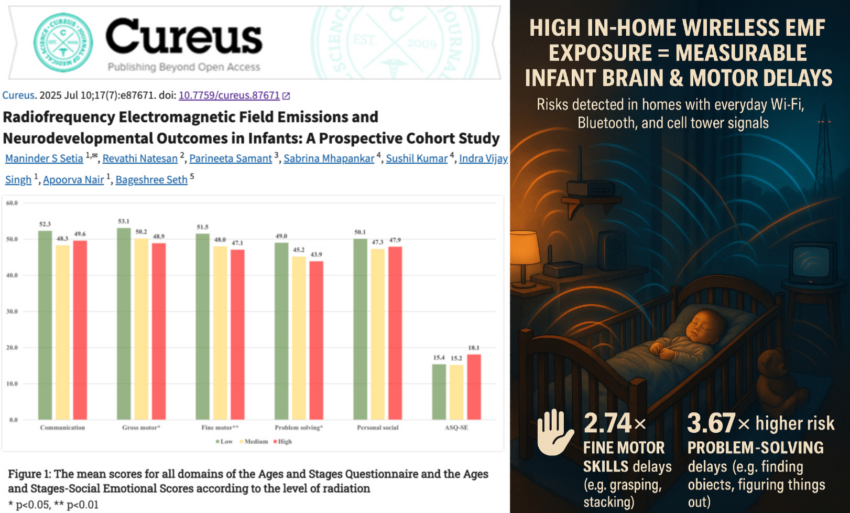A major new study titled, Radiofrequency Electromagnetic Field Emissions and Neurodevelopmental Outcomes in Infants: A Prospective Cohort Study, has delivered one of the clearest warnings yet about the effects of everyday wireless radiation on babies.
Unlike past research based on phone-use surveys, this team directly measured radiofrequency electromagnetic fields (RF-EMF) inside homes — from sources like cell towers, Wi-Fi routers, cordless phones, and Bluetooth devices — and tracked real brain and motor development in infants over their first year.
The result? Higher in-home radiation was strongly linked to delays in fine motor skills, problem-solving ability, and social development — even after accounting for birth weight, maternal age, and income level.
What They Measured
Scientists went into homes with a professional spectrum analyzer, measuring total RF-EMF from all sources in the living environment — not just cell towers.
This included:
-
Wi-Fi routers (often running 24/7)
-
Cordless phones and their base stations
-
Bluetooth devices like speakers, earbuds, and baby monitors
-
Nearby cell towers
-
Smart TVs, tablets, and smart home hubs
Homes were split into three exposure groups:
-
Low: ~0.62 mW/m² — typical of homes without Wi-Fi, few wireless devices, and minimal cell tower signal nearby.
-
Medium: ~8.66 mW/m² — common in homes with a single always-on Wi-Fi router, occasional Bluetooth use, and moderate cell tower presence.
-
High: ~32.36 mW/m² — often found in modern homes with multiple wireless devices (Wi-Fi, Bluetooth, smart gadgets) and close proximity to a cell tower.
Infant development was assessed using the gold-standard Ages & Stages Questionnaire, 3rd Edition (ASQ-3), a validated screening tool that measures skills across communication, motor abilities, problem-solving, and social interaction.
Fine Motor Skills Impairment
-
High vs. Low EMF exposure: Babies were 2.74× more likely to have hand–eye coordination delays (95% CI: 1.10–6.78, p=0.03).
Example: trouble grasping objects, stacking blocks, or picking up small items.
Problem-Solving Difficulties
-
High vs. Low EMF: 3.67× higher risk of delays (95% CI: 1.41–9.55, p=0.008).
-
Medium vs. Low EMF: 3.12× higher risk (95% CI: 1.22–8.00, p=0.017).
Example: struggling to find a hidden toy or figure out how to reach something — early signs of reasoning ability.
Social Development Delays
-
Medium vs. Low EMF: Nearly 2.7× higher odds of personal-social delays (95% CI: 0.95–7.50, p=0.062, not statistically significant).
-
High-exposure homes had the highest share of babies with emotional/social issues — 11.5% compared to 0% in low-exposure homes.
Distance From Tower Didn’t Matter
-
How far the home was from the nearest cell tower didn’t change the risk.
-
This means in-home devices (Wi-Fi routers, cordless phones, Bluetooth gadgets) may be driving much of the exposure.
This study shows that everyday wireless radiation — at levels most people consider “normal” — may quietly harm infant brain development. Babies in high-radiation homes faced two to nearly four times the odds of developmental delays in critical brain and motor skills within just 12 months.
Add this to the growing list of documented EMF health risks: headaches, sleep disruption, fertility issues, cardiac effects, and cancer.
Despite insufficient safety data and growing evidence of biological effects, novel wireless technologies continue to be deployed unchecked, prioritizing corporate interests over public health:
Epidemiologist and Foundation Administrator, McCullough Foundation
www.mcculloughfnd.org
Please consider following both the McCullough Foundation and my personal account on X (formerly Twitter) for further content.
Click this link for the original source of this article.
Author: Nicolas Hulscher, MPH
This content is courtesy of, and owned and copyrighted by, https://petermcculloughmd.substack.com and its author. This content is made available by use of the public RSS feed offered by the host site and is used for educational purposes only. If you are the author or represent the host site and would like this content removed now and in the future, please contact USSANews.com using the email address in the Contact page found in the website menu.









